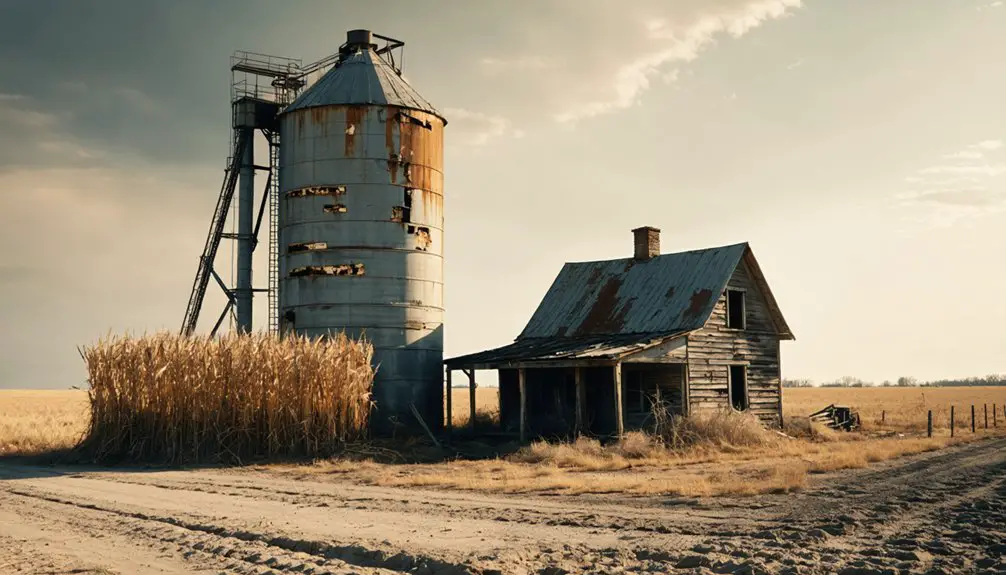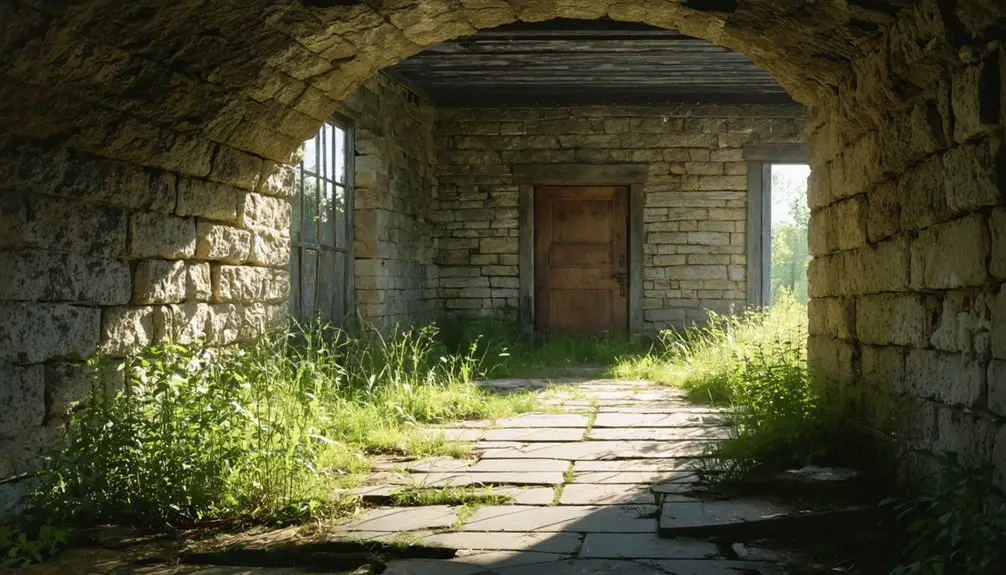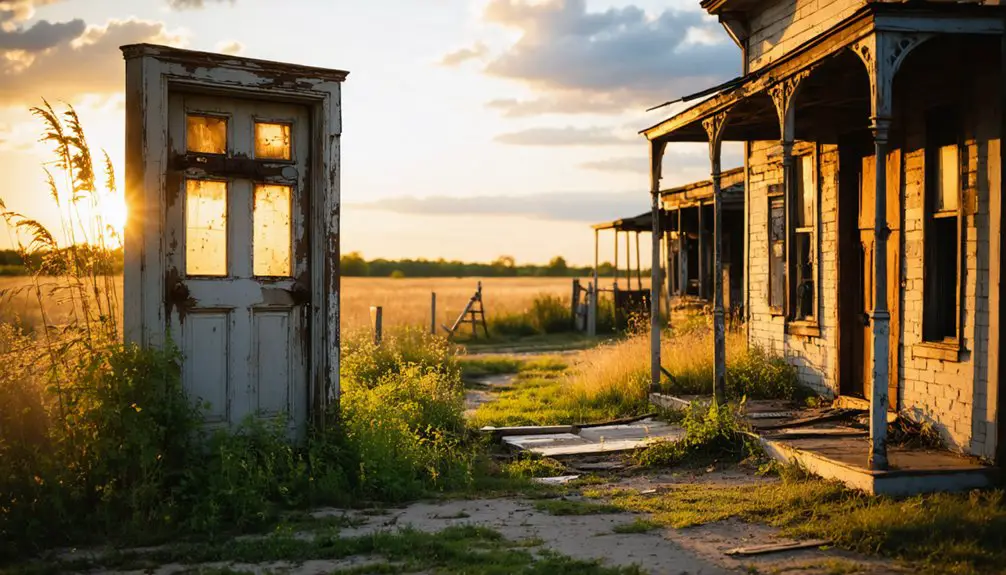You’ll find Lexington’s ghost town remains near DeSoto, Kansas, where pro-slavery settlers established this frontier community in 1855. The town thrived briefly with a bustling post office, general store, and blacksmith shop until 1927. Economic struggles from failing mines, lack of railroad connections, and the harsh 1930s Dust Bowl led to its abandonment. Beyond the weathered foundations and dirt roads, Lexington’s story reveals deeper tensions from Kansas’s turbulent territorial period.
Key Takeaways
- Lexington, Kansas was established in 1855 as a pro-slavery settlement near DeSoto, eventually becoming a ghost town due to economic decline.
- The town’s fate was sealed by its failure to secure railroad connections, leading to isolation from regional markets and economic opportunities.
- Mining operations initially sustained the community, but cheaper coal deposits elsewhere caused the local industry to collapse.
- The post office closure in 1927 and the school’s shutdown in 1964 marked major milestones in Lexington’s progression toward abandonment.
- Only architectural remnants, weathered foundations, and abandoned buildings remain as evidence of this former Kansas settlement.
The Rise and Fall of a Kansas Prairie Town
While many Kansas prairie towns rose and fell with changing fortunes, Lexington’s story stands out as a stark example of how economic dependencies can seal a community’s fate.
Isolated towns across Kansas faced similar challenges, with bad weather and mineral depletion driving their decline.
You’ll find Lexington’s community dynamics transformed dramatically from the early 1900s onward. When cheaper coal deposits emerged elsewhere in Kansas, the town’s economic foundation began to crumble. The strip mines that once supported over 600 residents couldn’t compete, forcing a dramatic economic shift from mining to farming and ranching. Economic depressions severely impacted the town’s commercial activities and population.
Without railroad connections, Lexington couldn’t adapt like nearby Ashland did. The town’s isolation grew as businesses and residents departed, leading to the closure of essential institutions. By 1964, even the local school had shut its doors.
Lacking vital rail links, Lexington withered into isolation as its population dwindled, watching helplessly as one institution after another vanished.
Natural disasters, including devastating tornadoes, delivered the final blows to this once-thriving prairie community.
Early Settlement and Community Development
As tensions over slavery intensified across Kansas Territory in 1855, a group of pro-slavery settlers established Lexington in northwestern Johnson County, just three miles from the antagonistic free-state town of DeSoto.
This settlement pattern reflected the broader political divisions sweeping through Kansas following the Kansas-Nebraska Act of 1854, with towns often emerging as either free-state or pro-slavery strongholds. Like many Southerners who made claims without residence, Lexington’s founders maintained strong ties to Missouri while attempting to establish their presence in Kansas Territory.
The emigrant aid companies from New England played no role in Lexington’s development, as they focused exclusively on supporting free-state settlements.
You’ll find that Lexington’s early development centered around a hotel that served travelers and new arrivals.
However, the town’s Southern sympathies and community conflicts with neighboring free-state settlements limited its growth potential.
While other Kansas towns expanded their infrastructure and attracted diverse settlers, Lexington’s pro-slavery stance increasingly isolated it from the region’s emerging economic and social networks.
Daily Life in 1880s Lexington
As you’d walk into Lexington’s post office in the 1880s, you’d find it serving as more than just a mail hub – it was the heart of daily communication and social interaction for local farmers and townspeople.
The postmaster’s counter doubled as a gathering spot where you could catch up on local news, arrange business deals, or coordinate community events while picking up your mail and packages. Much like Kansas City’s rapid expansion during this era, local growth largely depended on external investments to fuel development.
Beyond postal services, early businesses like the general store and blacksmith operated nearby, creating a small but crucial commercial center where you’d find essential supplies and services for your farm or household. The town’s early success was driven by its abundant water and coal resources, though this prosperity wouldn’t last without railroad access.
Post Office Community Hub
The creaking floorboards of Lexington’s post office welcomed a steady stream of residents during the 1880s, transforming this essential service hub into the beating heart of the Kansas community. Having once been hopeful for growth due to local water resources, the town’s post office served its residents until transportation needs shifted.
You’d find your neighbors exchanging news while collecting their mail, sharing stories of crop yields, or posting letters to distant relatives. Beyond simple postal services, the office served as your central point for community interactions, where local events were planned and business deals struck.
You could handle your financial transactions through money orders, receive packages from mail-order catalogs, or catch up on regional news. Like other place name associations, Lexington’s post office helped define the town’s identity.
The bustling atmosphere of Lexington’s post office reflected the town’s growth and prosperity, creating opportunities for commerce and employment that would sustain the community until its eventual closure in 1927.
Early Business Operations
Beyond the post office’s busy corridors, Lexington’s commercial district bustled with entrepreneurial spirit throughout the 1880s.
Like many towns near the Chisum Trail, Lexington attracted both local settlers and passing cattle drivers seeking supplies and entertainment.
You’d find remarkable business diversity across Main Street, where multiple general stores competed for your patronage alongside a well-stocked drugstore. The town’s retail competition fostered a vibrant marketplace that served both locals and travelers. Similar to Kansas Historical Society records of other ghost towns, the businesses that once thrived here now lie hidden beneath farmland.
- Essential services thrived with two skilled blacksmiths crafting tools and horseshoes.
- Professional offices housed a doctor and attorney to handle your medical and legal needs.
- Entertainment venues included dance halls and gambling establishments for your leisure.
- Multiple merchants supplied everything from lumber to grain storage, supporting your farming operations.
These enterprises formed the backbone of Lexington’s economy, though banking proved unstable with one institution’s brief existence.
The Post Office Era: 1880-1927
During Lexington’s peak years, mail services operated from a modest wooden structure that served as the town’s primary communication hub.
You’d find the postmaster dutifully managing mail distribution, connecting your isolated prairie community to the outside world through a network of horseback riders and stagecoaches. The position carried significant responsibility, as the postmaster handled not just letters but also managed money orders and maintained detailed postal records.
When the railroad arrived, you could count on faster mail delivery than ever before.
The post office became more than just a mail stop – it transformed into an essential center of community life where you’d gather news, handle financial transactions, and send telegrams.
This important service continued until 1927, providing Lexington’s residents with a key link to civilization during the town’s decline.
Environmental Challenges and Agricultural Impact

As environmental pressures mounted in Lexington during the 1930s, you’d witness the devastating combination of drought, poor land management, and resource depletion transform the once-productive farmland into barren earth.
Water scarcity struck hard as groundwater levels dropped, making it nearly impossible to maintain crops or livestock. The Dust Bowl years brought unrelenting challenges, with soil erosion stripping away precious topsoil that had sustained generations of farmers.
- Failed crops and declining yields forced many farming families to abandon their homesteads.
- Unreliable rainfall patterns and limited irrigation options crippled agricultural adaptation.
- Soil degradation and compaction made it increasingly difficult to maintain productive farms.
- Poor land stewardship led to widespread erosion, leaving fields vulnerable to further damage.
These environmental challenges ultimately contributed to Lexington’s decline and eventual abandonment.
Transportation Networks and Economic Decline
You’ll find Lexington’s decline was largely sealed by its inability to secure a crucial railroad connection, despite local investors building infrastructure in anticipation of rail service.
The town’s isolation from regional markets became more pronounced as neighboring communities with railroad access thrived through enhanced shipping capabilities and passenger transport.
While early residents relied on dirt roads and limited county routes, the absence of both rail service and later highway development effectively cut Lexington off from the economic arteries that sustained other Kansas towns.
Railroad Access Problems
When the railroads bypassed Lexington in the mid-19th century, the town’s fate was effectively sealed. During this era of aggressive railroad competition, towns across Kansas fought desperately for rail access, knowing it meant the difference between prosperity and decline.
You’ll find that Lexington’s transportation strategies were severely limited without this essential infrastructure, forcing residents to rely on less efficient means of moving goods and people.
- The town’s valuable coal and water resources couldn’t be effectively transported
- Investors quickly withdrew their capital once railroad plans changed
- Local businesses couldn’t compete with rail-connected towns
- The population steadily declined as economic opportunities vanished
Despite having natural resources that could’ve sustained growth, Lexington’s lack of rail access transformed it from a promising settlement into another Kansas ghost town, joining places like Bloom and Sitka in historical obscurity.
Highway Development Effects
The evolution of highway networks in Kansas during the early 20th century dealt another blow to Lexington’s survival prospects. When major routes like US 54 bypassed the town, you’d have seen a swift decline in through-traffic and commerce.
While neighboring towns like Bloom and Englewood thrived with their highway connections, Lexington’s highway isolation cut it off from regional markets and transport networks.
The town’s economic marginalization intensified as businesses dependent on passing travelers closed their doors. In the 1920s, when communities campaigned for stone-surfaced highways linking major cities like St. Louis and Kansas City, Lexington lacked the resources to lobby effectively.
This exclusion from key transportation corridors created a downward spiral – as population dwindled, the chances of securing future highway connections diminished, ultimately sealing the town’s fate.
Notable Residents and Local Stories

Among Lexington’s most influential figures stands James H. Lane, a fierce abolitionist known as “The Grim Chieftain.” His legacy shaped the town’s identity during the turbulent “Bleeding Kansas” era, as he led troops and established the first African American regiments in the Union Army.
James Lane’s fierce abolitionist spirit and military leadership transformed Lexington during the violent struggles of Bleeding Kansas.
You’ll find traces of vigilante justice and frontier defense woven through Lexington’s history, reflecting its position near the lawless Oklahoma territory.
- Lane’s Trail passed near town, serving as a crucial Underground Railroad route for escaped slaves.
- Local settlers built defensive structures to protect against proslavery forces.
- Street-side hangings and gunfights were common forms of frontier justice.
- The town witnessed frequent conflicts between neighboring communities until its decline in 1927.
Neighboring Ghost Towns and Regional Context
Situated within Clark County’s vast prairie landscape, Lexington wasn’t alone in its eventual decline. Just southwest of Minneola, you’ll find the remains of Letitia, another ghost town that fell victim to the region’s harsh realities.
Together, they’re part of a broader pattern of settlement abandonment that swept through southwest Kansas during the early 20th century.
As you explore the area’s regional heritage, you’ll discover similar stories across neighboring counties. From Comanche County’s lost settlements to Meade County’s Pierceville, these ghost towns share common threads: they emerged during the railroad era, flourished briefly, then succumbed to forces like the Dust Bowl, mechanized farming, and shifting transportation routes.
Today, they stand as compelling destinations for ghost town tourism, offering glimpses into the boom-and-bust cycles that shaped Kansas’s frontier spirit.
Architectural Remnants and Physical Legacy

Scattered across Lexington’s prairie landscape, wooden structures and weathered foundations tell the story of this once-thriving Kansas settlement.
You’ll find architectural decay everywhere you look – from collapsing rooflines to nature’s slow reclamation of building frames. Without historical preservation efforts, these remnants continue to fade into the Kansas countryside.
- Weather-beaten houses showcase early 20th-century construction, with simple wood frames that have endured decades of harsh elements.
- Stone and brick foundations outlast their wooden counterparts, marking where homes once stood proud.
- Former dirt roads, now barely visible, weave through clusters of abandoned residential and business zones.
- Barns and outbuildings, stripped of doors and windows, stand as silent witnesses to the area’s agricultural past.
Modern-Day Significance and Historical Documentation
While physical remnants of Lexington slowly fade into the Kansas prairie, the town’s legacy endures through modern documentation and local cultural memory.
You’ll find its story preserved in postal records spanning from the 1880s to 1927, and through a historical marker that draws ghost town tourism enthusiasts to Clark County.
The town’s cultural heritage lives on through oral histories and local lore, particularly stories of its strategic position near “No Man’s Land” and the Oklahoma territory.
Today, educators and historians use Lexington as a compelling example of how railroad decisions shaped the fate of frontier settlements.
Local families maintain the old cemetery and keep the town’s memory alive through documentaries and storytelling, ensuring this piece of Kansas history won’t be forgotten.
Frequently Asked Questions
Are There Any Remaining Structures Still Standing in Lexington Today?
You’ll find very few remaining buildings in Lexington today – mainly a grain elevator that’s partially operational, plus one other unspecified structure. The town’s historical preservation efforts couldn’t save most structures.
What Native American Tribes Originally Inhabited the Lexington Area?
You’ll find the Kanza (Kaw), Osage, and Pawnee tribes were the primary Native American inhabitants of this area, with Delaware, Sauk, Fox, and Kickapoo tribes also sharing the region’s tribal history.
Did Any Famous Outlaws or Lawmen Pass Through Lexington?
While you’d expect famous outlaws to have passed through due to the town’s location near No Man’s Land and Dodge City, there’s no direct evidence of specific lawmen or outlaws visiting Lexington.
Were There Any Local Legends or Ghost Stories About Lexington?
You’ll hear tales of local hauntings near the old border town, with ghost sightings often linked to violent conflicts from No Man’s Land and the struggles between settlers and outlaws during the 1880s.
What Happened to the Cemetery and Burial Records From Lexington?
Like autumn leaves scattered by time, you’ll find the cemetery records and burial sites have vanished – no deed records exist, no headstones remain visible, and no thorough documentation survives in Kansas databases.
References
- https://www.youtube.com/watch?v=Pf5n1PX1g3M
- https://abandonedforgottendecayed.com/2017/02/11/the-wooden-bones-of-kansas/
- https://www.youtube.com/watch?v=HpolfSLrhsE
- https://en.wikipedia.org/wiki/Lexington
- https://legendsofkansas.com/kansas-ghost-town-list/
- https://www.hhhistory.com/2019/05/ghost-towns-of-kansas.html
- https://www.youtube.com/watch?v=gkfXLg-ftys
- https://stephentravels.com/top5/ghost-towns/
- https://www.kspatriot.org/index.php/articles/13-kansas-people/439-the-coming-of-the-settlers.html
- https://legendsofkansas.com/kansas-settlers/



